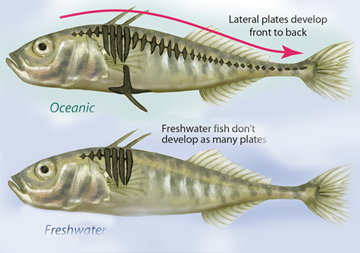Click on image for full size
Windows to the Universe original image
Related links:
Evolution Hits the Beach - streaming RealVideo (1 min. 7 sec.) from NSF
Genetics of Self-Sacrifice - streaming RealVideo (1 min. 19 sec.) from NSF
Changing Planet: Changing Mosquito Genes Classroom Activity and Video
Changes to the Gene Pool: Microevolution
There can be many different forms of a gene. All of the versions of the genes in a population of a species are together called the gene pool. The gene pool does not always stay the same. Over generations, small changes in the amount of each type of gene can happen for a number of reasons.
- Gene mutation: An error during cell division can create a new type of gene. That new gene is a small part of the gene pool. It can be passed on to the next generation. If the new gene is useful, it might become a common part of the gene pool.
- Gene flow: if new individuals of the species move into or out of the region, it can affect the gene pool. For instance, the only people in North America were once Native Americans. Immigration from other parts of the world over the last several hundred years has changed the gene pool a lot.
- Genetic drift: The amount of each gene in a gene pool can change over time because of chance events. For instance, if a few individuals leave a population and establish a new one, by chance their gene pool may not have the same frequency of genes as in the population they left. For example, plants that get to islands as seeds stuck to the feet of birds or in their stomachs may not be typical of their species, but they become the gene pool on the island.
- Natural selection: Some genetic differences will improve the chance of survival of individuals that have them. For instance, hawks with large sharp talons may be more likely to survive than hawks with small talons. Since the surviving ones make the next generation, the genes for large talons are more likely to be passed on. Eventually, the gene pool shifts towards large talons.
Microevolution is changes in the gene pool of a population over time that result in changes to the varieties of individuals in a population. Examples of microevolution include bacteria that have become unaffected by antibiotics, or a change in a species' coloring or size. If the changes are over a very long time and are large enough that the population is no longer able to breed with other populations, it is considered a different species. This is called macroevolution.















